Protective effects of relaxin in ischemia/reperfusion-induced intestinal injury due to splanchnic artery occlusion
- PMID: 16847443
- PMCID: PMC1752008
- DOI: 10.1038/sj.bjp.0706811
Protective effects of relaxin in ischemia/reperfusion-induced intestinal injury due to splanchnic artery occlusion
Abstract
1. Splanchnic artery occlusion (SAO) followed by reperfusion causes endothelial injury and inflammation which contribute to the pathophysiology of shock. We investigated the effects of relaxin (RLX), known to afford protection against the deleterious effects of cardiac ischemia/reperfusion, given to rats subjected to splanchnic artery occlusion and reperfusion (SAO/R)-induced splanchnic injury. 2. RLX (30 ng kg(-1), 15 min. before reperfusion) significantly reduced the drop of blood pressure and high mortality rate caused by SAO/R. RLX also reduced histopathological changes, leukocyte infiltration (myeloperoxidase) and expression of endothelial cell adhesion molecules in the ileum. RLX counteracted free radical-mediated tissue injury, as judged by significant decrease in the tissue levels of peroxidation and nitration products (malondialdehyde, nitrotyrosine), DNA damage markers (8-hydroxy-2'-deoxyguanosine, poly-ADP-ribosylated DNA) and consumption of tissue antioxidant enzymes (superoxide dismutase). As a result, RLX led to a reduction of ileal cell apoptosis (caspase 3, terminal deoxynucleotidyltransferase-mediated UTP end labeling). The effects of RLX appear specific, as inactivated RLX substituted for the bioactive hormone had no effects. 3. In conclusion, these results show that RLX exerts a clear-cut protective effect in SAO/R-induced splanchnic injury, likely due to endothelial protection, decreased leukocyte recruitment and hindrance of free radical-mediated tissue injury leading to cell death, lethal complications and high mortality rate. Thus, RLX could be used therapeutically in intestinal ischemia.
Figures

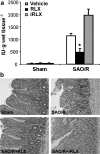
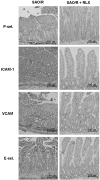
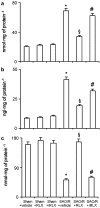
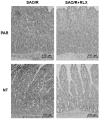
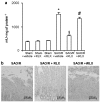
Similar articles
-
Beneficial effects of a plant histaminase in a rat model of splanchnic artery occlusion and reperfusion.Shock. 2007 Apr;27(4):409-15. doi: 10.1097/01.shk.0000239763.97958.84. Shock. 2007. PMID: 17414424
-
Protective effects of a new stable, highly active SOD mimetic, M40401 in splanchnic artery occlusion and reperfusion.Br J Pharmacol. 2001 Jan;132(1):19-29. doi: 10.1038/sj.bjp.0703775. Br J Pharmacol. 2001. PMID: 11156557 Free PMC article.
-
Beneficial effects of 3-aminobenzamide, an inhibitor of poly (ADP-ribose) synthetase in a rat model of splanchnic artery occlusion and reperfusion.Br J Pharmacol. 1997 Jul;121(6):1065-74. doi: 10.1038/sj.bjp.0701234. Br J Pharmacol. 1997. PMID: 9249240 Free PMC article.
-
Relaxin as a cardiovascular drug: a promise kept.Curr Drug Saf. 2011 Nov 1;6(5):324-8. doi: 10.2174/157488611798918719. Curr Drug Saf. 2011. PMID: 22424540 Review.
-
Mechanisms of the protective effects of transforming growth factor-beta in reperfusion injury.Biochem Pharmacol. 1991 Sep 12;42(7):1323-7. doi: 10.1016/0006-2952(91)90441-7. Biochem Pharmacol. 1991. PMID: 1930256 Review.
Cited by
-
Early Anti-inflammatory and Pro-angiogenic Myocardial Effects of Intravenous Serelaxin Infusion for 72 H in an Experimental Rat Model of Acute Myocardial Infarction.J Cardiovasc Transl Res. 2017 Dec;10(5-6):460-469. doi: 10.1007/s12265-017-9761-1. Epub 2017 Jul 17. J Cardiovasc Transl Res. 2017. PMID: 28718055
-
Cardiovascular effects of relaxin: from basic science to clinical therapy.Nat Rev Cardiol. 2010 Jan;7(1):48-58. doi: 10.1038/nrcardio.2009.198. Epub 2009 Nov 24. Nat Rev Cardiol. 2010. PMID: 19935741 Review.
-
Effects of human relaxin-2 (serelaxin) on hypoxic pulmonary vasoconstriction during acute hypoxia in a sheep model.Hypoxia (Auckl). 2018 May 22;6:11-22. doi: 10.2147/HP.S165092. eCollection 2018. Hypoxia (Auckl). 2018. PMID: 29862306 Free PMC article.
-
Serelaxin reduces oxidative stress and asymmetric dimethylarginine in angiotensin II-induced hypertension.Am J Physiol Renal Physiol. 2014 Dec 15;307(12):F1355-62. doi: 10.1152/ajprenal.00407.2014. Epub 2014 Oct 8. Am J Physiol Renal Physiol. 2014. PMID: 25298524 Free PMC article.
-
Relaxin ameliorates hypertension and increases nitric oxide metabolite excretion in angiotensin II but not N(ω)-nitro-L-arginine methyl ester hypertensive rats.Hypertension. 2011 Aug;58(2):197-204. doi: 10.1161/HYPERTENSIONAHA.110.164392. Epub 2011 Jun 13. Hypertension. 2011. PMID: 21670419 Free PMC article.
References
-
- ALTURA B.M., GEBREWOLDA A., BURTON R.W. Reactive hyperaemic responses of single arterioles are attenuated markedly after intestinal ischemia, endotoxemia and traumatic shock: possible role of endothelial cells. Microcirc. Endoth. Lymp. 1985;2:3–14. - PubMed
-
- BANI D. Relaxin: a pleiotropic hormone. Gen. Pharmacol. 1997;28:13–22. - PubMed
-
- BANI D., FAILLI P., BELLO M.G., THIEMERMANN C., BANI SACCHI T., BIGAZZI M., MASINI E. Relaxin activates the L-arginine-nitric oxide pathway in vascular smooth muscle cells in culture. Hypertension. 1998a;31:1240–1247. - PubMed
-
- BITTERMANN H., AOKI N., LEFER A.M. Anti-shock effects of human superoxide dismutase in splanchnic occlusion shock. Proc. Soc. Exp. Biol. Med. 1988;188:256–271. - PubMed
Publication types
MeSH terms
Substances
LinkOut - more resources
Full Text Sources
Research Materials

